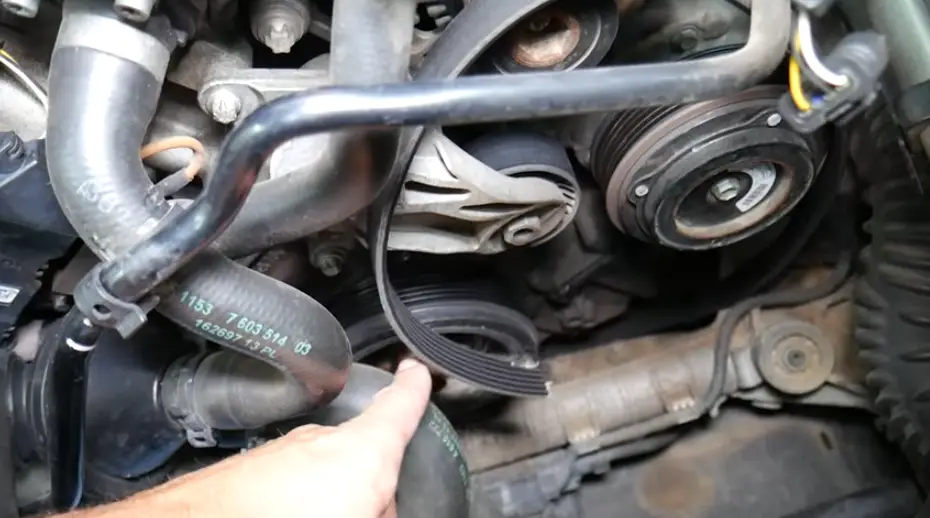If the serpentine belt breaks while driving, you’ll lose power steering, electrical systems, and engine cooling. Pull over safely and call for assistance to avoid further damage. Regular maintenance can prevent this issue.
The serpentine belt, often referred to as the “drive belt,” is a critical component in your vehicle’s engine. It drives several important accessories, including the alternator, power steering pump, water pump, air conditioning compressor, and, in some cases, the cooling fan. If this belt breaks while driving, it can lead to significant consequences for your vehicle’s performance and safety.
This blog post explores what happens when a serpentine belt breaks, why it might fail, what to do in such a situation, and how to prevent it from happening.

Contents
What is a Serpentine Belt?
The serpentine belt is a long, rubber belt that winds through several pulleys to power various engine accessories. Unlike older vehicles, which often used multiple V-belts to operate different systems, modern vehicles typically rely on a single serpentine belt. This design is more efficient, but it also means that if the belt fails, all the systems it powers will stop functioning.
What Happens When the Serpentine Belt Breaks While Driving?
If your serpentine belt breaks while you’re on the road, here’s what you can expect:
1. Loss of Power Steering
Most modern vehicles rely on the serpentine belt to drive the power steering pump. Without it, steering becomes extremely difficult, especially at lower speeds. This can make navigating or turning corners dangerous.
2. Electrical System Failure
The alternator, which charges the battery and powers the electrical systems, is driven by the serpentine belt. When the belt breaks, the battery takes over, but it will eventually deplete, leaving you with no power for essential functions like lights, wipers, or electronic controls.
3. Engine Overheating
If the serpentine belt drives the water pump, its failure will halt the coolant flow, causing the engine to overheat. Overheating can lead to severe engine damage if not addressed promptly.
4. Loss of Air Conditioning
While not critical to engine operation, the loss of air conditioning can be uncomfortable, especially in hot weather.
Steps to Take When the Serpentine Belt Breaks While Driving
If your serpentine belt breaks, here’s what you should do:
- Remain Calm: Stay composed and avoid panicking. A broken serpentine belt is serious, but the vehicle will still run briefly, giving you time to act.
- Turn Off Unnecessary Systems: Shut off the air conditioning, radio, and other non-essential electrical systems to conserve battery power.
- Monitor the Temperature Gauge: If the engine begins to overheat, stop the car immediately. Continuing to drive an overheating engine can cause irreparable damage.
- Pull Over Safely: Find a safe place to pull over, preferably away from traffic. Turn on your hazard lights to alert other drivers.
- Call for Assistance: You’ll likely need a tow truck to take your vehicle to a mechanic. Driving without a serpentine belt is not safe and can lead to further damage.
Why Do Serpentine Belts Break?
Several factors can cause a serpentine belt to break:
- Wear and Tear: Over time, the belt naturally degrades due to constant use, heat, and friction. Regular inspections can help identify wear before failure occurs.
- Misaligned Pulleys: If the pulleys that the belt runs through are misaligned, the belt can wear unevenly and eventually snap.
- Tensioner Failure: The belt tensioner maintains proper tension on the serpentine belt. If it fails, the belt can become loose, slip, or break.
- Contamination: Oil or coolant leaks can degrade the rubber of the serpentine belt, leading to failure.
- Manufacturing Defects: Although rare, defects in the belt material or design can cause premature failure.
Preventing Serpentine Belt Failure
To avoid being stranded due to a broken serpentine belt, follow these preventative measures:
- Regular Inspections: Inspect the belt every 10,000 miles or as recommended by your vehicle’s manufacturer. Look for cracks, fraying, or other signs of wear.
- Replace on Schedule: Most serpentine belts need replacement every 60,000–100,000 miles. Check your owner’s manual for the specific interval for your vehicle.
- Check Tensioner and Pulleys: Have a mechanic inspect the belt tensioner and pulleys during routine maintenance to ensure they are functioning properly.
- Address Leaks Promptly: Fix oil or coolant leaks as soon as they’re detected to prevent belt contamination.
- Use Quality Parts: When replacing the belt, opt for high-quality parts to ensure durability and reliability.
Frequently Asked Questions
Here are some FAQs about serpentine belt failure –
1. Can I drive without a serpentine belt?
No. Without a serpentine belt, critical systems like the alternator, water pump, and power steering won’t function. Continuing to drive can cause engine damage and compromise your safety.
2. How long does it take to replace a serpentine belt?
In most cases, replacing a serpentine belt takes about 30 minutes to an hour, depending on the vehicle and accessibility of the belt.
3. What’s the cost to replace a serpentine belt?
The cost varies based on the vehicle and labor rates, but it typically ranges from $50 to $200 for parts and labor.
4. What are the consequences of ignoring serpentine belt wear?
Neglecting a worn serpentine belt can lead to sudden failure, resulting in loss of power steering, electrical systems, and engine cooling, potentially causing significant damage and safety risks.
5. Is a serpentine belt the same as a timing belt?
No. The serpentine belt powers engine accessories, while the timing belt synchronizes the engine’s internal components. These belts serve different purposes and are not interchangeable.
Conclusion
A serpentine belt failure can be inconvenient and potentially dangerous. Recognizing the signs of wear and performing regular maintenance can help prevent unexpected breakdowns. If your serpentine belt breaks while driving, act quickly and safely to minimize risks and avoid further damage to your vehicle.